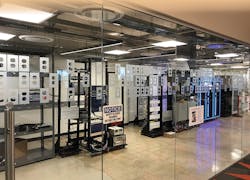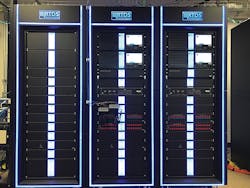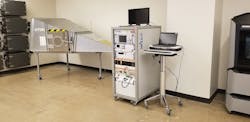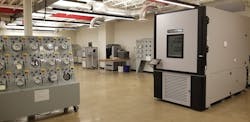New challenges require new capabilities. Electric utilities are turning to advanced technologies to help meet increasing demand for sustainable distributed energy resources (DER) and to enhance the resiliency of their systems to protect against more frequent and severe storms, as well as other potential threats. But, from where do these new solutions emerge?
In the last two years, Commonwealth Edison Co. (ComEd) of Chicago, Illinois, U.S., has invested in building three laboratories with almost 50,000 sq ft (4645 sq m) of space. These labs represent a crucial component of the utility’s broader strategy to test, refine, and demonstrate technologies that enable it to provide a premier customer experience.
In 2018, ComEd opened a “Grid of the Future Lab” within its new Chicago training center on the city’s South Side. This state-of-the-art lab is designed with advanced digital technology to refine and demonstrate cutting-edge technologies that support resilience and sustainability. The utility also is building a Forensics Lab for testing and evaluating electrical distribution equipment that can help to avoid outages and improve reliability. In addition, it installed a Smart City Lab, designed to maximize the value of the advanced metering infrastructure (AMI) installed throughout northern Illinois and that supports smart streetlights and water meters, advanced energy-efficiency technologies as well as other emerging smart city solutions. Together, the technologies in these labs help ComEd to meet any challenge that emerges.
The ‘Grid of the Future’ Lab
As there is a growing understanding of the need for a more resilient and sustainable grid, ComEd is adding capabilities to develop and demonstrate emerging technologies, support standards development and compliance, and train a workforce that is prepared to operate this advanced grid equipment. The Grid of the Future Lab is sited at two ComEd locations, its Chicago training center and its technical center in the neighboring suburb of Maywood, Illinois.
Already, the utility has used the lab to fulfill its commitment to the U.S. Department of Energy (DOE) for the design and development of a cutting-edge microgrid master controller, which will be used to control the Bronzeville community microgrid. The master controller will be connected to the microgrid already serving the nearby campus of the Illinois Institute of Technology, creating the first utility-operated microgrid cluster in the nation. ComEd also has used the lab to demonstrate a microgrid integrated solar storage technology (MISST), a key step toward making microgrids even more sustainable and resilient.
Following is other work underway at the Grid of the Future Lab:
- Developing a new distribution linear state estimation (DLSE) capability — This supports the penetration of DER and helps to ensure the cybersecurity of the grid, by identifying and correcting bad data.
- Fulfilling ComEd’s commitments to a series of DOE supported projects — This includes the development of a cybersecure extreme fast-charging (XFC) electric vehicle station, which will support communities as they seek to shift from high-carbon forms of energy, like gasoline, and provide an additional resource in ComEd’s efforts to maintain the cybersecurity of the grid.
- Creating industry compliance standards using capabilities such as power hardware in the loop (PHIL) — This provides the necessary environment to test and ensure alignment with standards that promote the integration of DER.
- Supporting the testing needs of a wide range of the utility’s departments — These include distribution planning and smart grid, T&D design and engineering, and real-time analysis. This also enables ComEd to develop its workforce capabilities. For example, using real-time digital simulation (RTDS) creates a safe environment for operator testing of microgrid controllers, distribution automation and smart inverters. This is the equivalent of a flight simulator, enabling grid operators to gain experience in difficult situations yet in a safe environment.
- Supporting further collaboration with universities, research institutions, and programs that introduce talented high school students to electrical engineering principles and smart city technologies — This helps to promote development of skills in science, technology, engineering and math.
Improved Reliability
Innovation must be built on a foundation of reliable infrastructure, which is why ComEd also established a 5700-sq ft (530-sq m) Forensics Lab in Maywood to review new and retired equipment and materials. This facility includes lab space for ComEd personnel to perform testing and failure analysis of equipment and build mock-ups to simulate field concerns.
As utilities experience equipment failure, it is crucial to have the ability to determine the reason for the failure so it does not happen again. This lab enables ComEd to increase significantly the analysis of equipment replaced in the field that no longer meets operating standards. This analysis improves statistically relevant trends and insights that can inform changes in products, installation methodologies, reliability programs, and instruction and training to provide higher levels of service.
Ultimately, the long-term strategy is to study and strategically adopt fault tree analysis (FTA). FTA identifies the root cause of failures more granularly and repeatably, systematically revealing the changes in processes or procedures that may have the widest strategic impact in improving the targeted safety, resiliency, and reliability of the material.
Smart Grid, Smart City
Using this foundation, ComEd is pursuing technologies that will enable its customers to leverage the smart grid fully to meet their specific needs. Occupying 35,000 sq ft (3251 sq m) in ComEd’s technical center in Maywood, the Smart City Lab tests the interoperability of a variety of devices interconnected to ComEd’s AMI, including smart meters, smart streetlights, smart water meters as well as grid-edge devices and behind-the-meter devices.
Each of these devices affects community lives in different ways. For example, smart meters help customers to understand their energy usage better. This enables them to make informed decisions about when and how much electricity they use, which helps to reduce their bills and carbon footprint. Smart streetlights not only ensure the relevant authorities know when a light is out, and potentially endangering the safety of neighborhoods, but they also can enable future smart city solutions. Smart water meters can potentially reduce the cost of receiving water, but they also aid in identifying leaks, which supports sustainability. Together, these technologies help communities and stakeholders to meet their objectives of enhancing sustainability and resilience.
In addition, ComEd groups — including AMI operations, demand response, energy efficiency, meter standards and smart grid — use the Smart City Lab to develop and demonstrate technologies that can enable the utility to function as a platform. As electric utilities transition from simply transmitting and distributing electricity to pursuing additional opportunities to leverage the infrastructure in innovative ways and enhance community life, this lab enables more comprehensive meter and communications network testing. This provides a more accurate representation of the production AMI network that will make it possible for these additional devices and technologies to be incorporated.
Smart City Lab test equipment includes everything from a temperature chamber that enables engineers to test equipment in an environment similar to the extreme weather seen in the ComEd service territory to an outside smart meter farm that makes it possible to evaluate software updates and the behavior of meters under nonideal conditions.
Up Next
Technology matters, but the real significance is what can be done with it. ComEd is focused not only on maximizing the use of individual labs but also envisions a future where labs become part of a new smart utility platform that acts as a clearinghouse for the exchange of ideas, information, and services and connects customers to multiple energy solutions and providers. Proximity between several ComEd labs will support the sharing of technologies and lessons learned. The grid-edge devices evaluated in the Smart City Lab then can be tested for interoperability with grid control devices in the Grid of the Future Lab. Similarly, the results of simulations in the Grid of the Future Lab will provide a better understanding of the value of technologies like demand response, informing efforts to evaluate technologies that can accomplish this in the Smart City Lab.
In the new normal, the grid increasingly is required to do more. The expectation for the electric system used to be simply to provide power when it was needed. Today, stakeholders and communities are encouraging utilities to not only be reliable but also resilient in the face of disruptive events, such as cyberattacks and severe weather; leverage communications infrastructure that enables smart city technologies like smart streetlights; and integrate clean energy technologies that make it possible to mitigate the effects of climate change.
Advanced electric utilities have the responsibility and the opportunity to implement solutions that meet the expectations of the communities that rely so deeply on the grids they operate. However, all of this begins with rigorous testing, refinement, evaluation and demonstration of the technologies that can make them possible. ComEd’s labs are significant separately, but together, they provide the unified capabilities necessary to create smart city solutions on a foundation enabled by a grid that is smarter, more sustainable and more resilient.
For more information:
ComEd | www.comed.com






